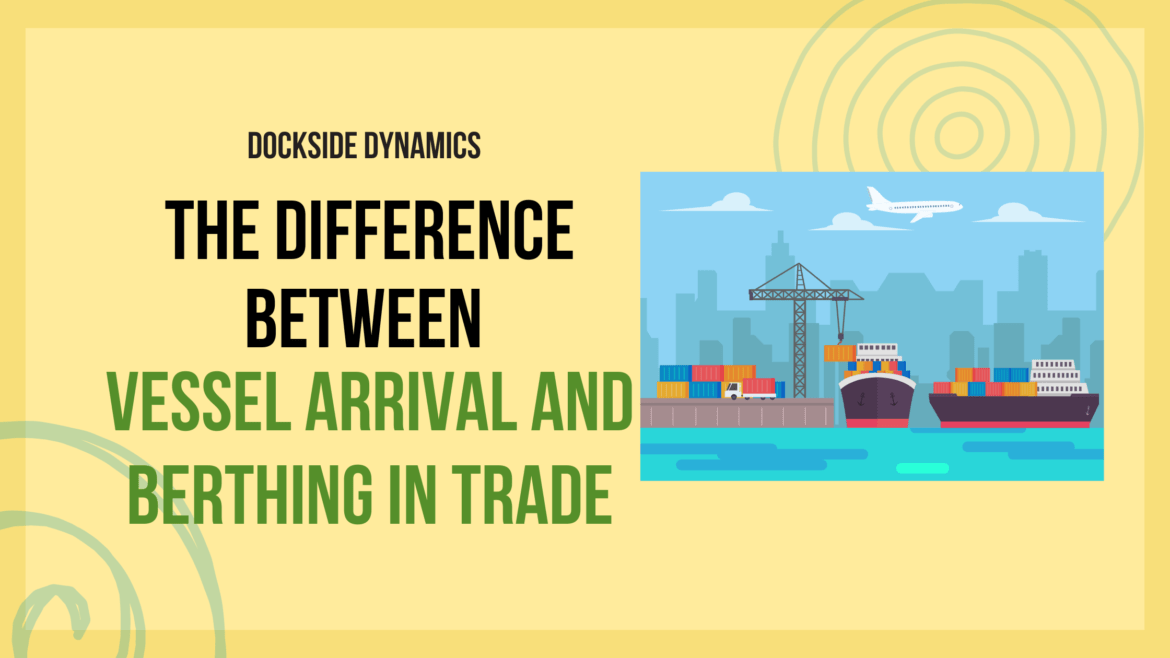In the intricate world of international trade, the efficient movement of goods relies heavily on maritime transportation. As goods journey across oceans to reach their destinations, two pivotal events mark the progress of a vessel: The difference Between vessel arrival and berthing. While these terms might appear synonymous, they encompass distinct stages in the maritime logistics chain. This blog delves into the nuances of vessel arrival and berthing, shedding light on their significance and impact on global trade.
Unraveling Vessel Arrival
1. Definition:
Vessel arrival refers to the moment when a maritime vessel, such as a cargo ship or container vessel, physically reaches the port’s vicinity. At this point, the vessel has entered the port’s designated waters but has not yet been positioned at a berth.
2. Significance:
Vessel arrival is a critical event that triggers a sequence of activities. It marks the commencement of various pre-berthing procedures, including customs clearance, port formalities, and cargo documentation verification.
Berthing: A Deeper Dive
1. Definition:
Berthing involves the process of a vessel maneuvering and securing itself at a designated berth or quay within the port. This is the phase where the vessel aligns itself with the dock, allowing for the loading and unloading of cargo.
2. Operational Aspects:
Berthing demands precision and coordination. Skilled port pilots guide the vessel through navigational challenges, and tugboats assist in positioning the vessel alongside the berth. Once berthed, cranes and other equipment are engaged for cargo handling.
Key Distinctions
1. Timing:
Vessel arrival occurs before berthing. Arrival signifies the vessel’s presence in the port’s waters, while berthing involves the vessel’s docking and attachment to a berth.
2. Port Operations:
Vessel arrival initiates port operations such as customs procedures and cargo readiness checks. Berthing, on the other hand, initiates cargo handling, loading, and unloading activities.
Implications for Global Trade
1. Efficiency and Time Management:
Efficient vessel arrival and berthing operations are essential for minimizing delays and optimizing port utilization. Delays at either stage can cascade into disruptions throughout the supply chain.
2. Cargo Flow and Inventory Management:
Berthing directly impacts cargo flow. Swift berthing ensures timely cargo handling, reducing inventory holding costs and enhancing supply chain efficiency.
The Synchronization of Operations
1. Pre-Berthing Preparations:
Once a vessel arrives, pre-berthing preparations are set into motion. These include administrative tasks such as customs declarations, documentation verification, and compliance checks. Port authorities collaborate with shipping agents and customs officials to ensure that all regulatory requirements are met before the vessel can proceed to the berthing phase.
2. Navigation and Maneuvering:
As the vessel nears the port, skilled navigational experts, known as port pilots, come into play. These professionals are well-versed in the specific conditions and challenges of the port’s waters. Their expertise is crucial in guiding the vessel through potentially narrow channels, varying tides, and other navigational complexities to ensure a safe approach to the berth.
3. Tugboat Assistance:
Tugboats play an integral role in the berthing process. They provide additional propulsion and maneuverability to the vessel, assisting it in aligning with the berth accurately. Tugboat operators work in tandem with the ship’s crew to ensure a smooth and controlled docking procedure.
Berthing Challenges and Considerations
1. Weather Conditions:
Weather conditions can significantly impact the berthing process. Adverse weather, strong currents, or high winds can make maneuvering difficult and require heightened vigilance from both the ship’s crew and port personnel.
2. Port Infrastructure:
The availability of berths, quays, and sufficient water depth at the port is essential for successful berthing. Ports must have the necessary infrastructure to accommodate vessels of various sizes and types.
3. Port Congestion:
Port congestion can lead to delays in the berthing process. An efficient berth allocation system is crucial to ensure that vessels can dock and complete their operations without unnecessary wait times.
Berthing’s Impact on Supply Chains
1. Timely Cargo Handling:
Swift and efficient berthing directly influences the speed at which cargo can be loaded and unloaded. Timely cargo handling minimizes dwell times at ports, allowing goods to continue their journey through the supply chain promptly.
2. Inventory Management:
Effective berthing practices contribute to optimized inventory management. A well-organized berthing process ensures that cargo can be delivered to its intended destination on schedule, minimizing inventory holding costs.
The concepts of vessel arrival and berthing emerge as distinct yet interdependent stages. Vessel arrival serves as the precursor to berthing, marking the beginning of port-related processes. Berthing, in turn, signifies the vessel’s secure docking and cargo-handling phase.
As global trade evolves, a nuanced understanding of these dockside dynamics becomes paramount. Trade players who grasp the significance of timely vessel arrival and efficient berthing operations stand poised to navigate the complexities of international commerce with finesse.
In a world where the movement of goods defines economic progress, appreciating the subtleties between vessel arrival and berthing isn’t just a maritime insight – it’s a strategic advantage that ensures the seamless flow of trade across oceans.


1 comment
The Difference Between Vessel Arrival and Berthing in Trade